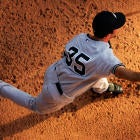Earlier on Tuesday, the Baseball Writers Association of America announced their 2019 Hall of Fame voting results. Four players will be enshrined in Cooperstown come July: pitchers Mariano Rivera (the first unanimous choice), Roy Halladay, Mike Mussina and designated hitter Edgar Martinez.
One of the ways we like to honor new inductees is by revisiting what scouts thought about them early in their careers -- an idea inspired by The Ringer's Ben Lindbergh. Thankfully, this is easy to accomplish these days using the Diamond Mines database housed at the Hall of Fame's website. You can visit the database here. Remember that scouts have an impossible job and that we're not highlighting any reports to mock or belittle them -- this exercise is simply to share snapshots of where these players were before their Hall of Fame careers took off.
Now, let's get to what the archives hold about the newly minted class.
Mariano Rivera
Searching for Rivera returns no results, but he makes an appearance in a 1995 writeup by then-Orioles scout John Stokoe. Stokoe saw Rivera about a month after his big-league debut (as a starter), and walked away impressed, noting that Rivera has a "real good, live arm" and the potential to be a "good major-league pitcher." Nonetheless, the line that garners the most attention is when Stokoe notes that Rivera "needs [an offspeed pitch] for the future." Rivera discovered a cutter, and used that pitch to great effect on his way to becoming the game's all-time saves leader.
Roy Halladay
The late Halladay took the scenic route in realizing his potential, requiring a complete mechanical overhaul as well as sports psychology work to salvage his career. Still, scouts who saw Halladay in high school believed he possessed special raw ingredients. A pair of White Sox scouts, Ed Pebley and George Bradley, each filed glowing reports on Halladay. Pebley graded both Halladay's fastball and curveball as future plus offerings, noting that he had the "chance to be front-line starter in future." Bradley went a step further, projecting Halladay's fastball as a plus-plus offering. Each scout observed that Halladay needed work on his mechanics, with Bradley stating that despite Halladay's power arsenal he "has [a lot] to correct in delivery."
Mike Mussina
It was obvious that Mussina was going to be a good pitcher, even while he was in high school. A report from the Major League Scouting Bureau graded his OFP -- his Overall Future Potential -- as 75.5. For reference, the highest possible OFP is 80. The closest thing to a pessimistic take was filed by a scout for the Angels, who gave Mussina the chance to develop average control and three average or better pitches. Oh, and that report was based on a game in which Mussina pitched in sub-optimal conditions. Mussina went on to attend Stanford before turning pro.
Edgar Martinez
At last, there's Martinez. As Lindbergh noted in 2014, Martinez was not particularly well-regarded. He received credit for being a "good contact bat," but was regarded as more of a Quad-A type than a legitimate stud. The scout in question also gave Martinez credit for solid defense -- a compliment that stands out given Martinez spent most of his career as a DH.


















